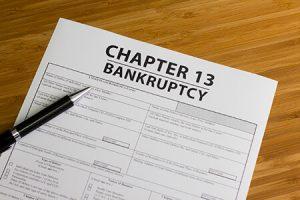
WHAT IS CHAPTER 13?
Chapter 13 is a commonly filed personal bankruptcy case which offers a payment plan for repayment of debt. Payment plans last between thirty-six and sixty months. The debtor makes monthly payments to a chapter 13 bankruptcy trustee. The trustee uses the money received to pay towards the debt owed. The debtor may pay all or a percentage of the total debt owed. Once the plan ends, the debtor is discharged all remaining unpaid debt.
WHY FILE CHAPTER 13?
There are two common reasons for filing chapter 13 bankruptcy. First, you don’t qualify for chapter 7 bankruptcy because your income is too high. In bankruptcy, there is a test for income qualifications. If your income is too high for chapter 7, then chapter 13 is the next choice. The income test reveals that you can afford to pay some or all of your debt back. Therefore, the amount left over after you pay your monthly expenses is called disposable income. The amount of disposable income you have will factor into your monthly payment plan.
Second, you have asset or assets that you would lose if you filed chapter 7. In some cases, a person might have secondary property such as a house or car, luxury items like expensive jewelry, artwork, or stocks or bonds that would be liquidated or sold by a chapter 7 trustee. However, in chapter 13, you keep all of your assets. A chapter 13 trustee will not force you to sell or liquidate anything. But, for you to keep those assets, you must agree to pay money towards your debt. You can do that by filing a chapter 13 plan.
WHAT IS A CHAPTER 13 PLAN?
A chapter 13 plan is an organization of your debt into one monthly payment. There are four types of debt in bankruptcy:
- Administrative debt, which is money owed to your attorney and the chapter 13 trustee. The chapter 13 trustee will get paid for the administration of your case.
- Secured debt, which is anything attached to collateral owned by you, i.e. your house or car secured by a mortgage or auto loan.
- Priority debt, there are two common examples of Priority debt, which are recently owed tax debt to the state or IRS, or domestic support obligations like child support or spousal maintenance.
- Unsecured debt, which most everything else falls into this category. For example, unsecured debt might include credit cards, student loans, medical debt, personal loans, pay day loans, etc.
In your chapter 13 plan, Administrative debt, Secured debt, and Priority debt must be paid off entirely during the lifetime of your plan. However, your mortgage would likely not be paid off in a five-year period, so other arrangements would be made for your mortgage payments. The remaining debt Unsecured debt would be paid a percentage of the total debt based on your disposable income. For example, if you owed $100,000 total unsecured debt and your disposable income allowed you to pay off 10% or $10,000 during your plan, then you would pay $10,000 over five years and be able to discharge $90,000 or 90 percent of your total unsecured debt in your chapter 13 plan.
Chapter 13 bankruptcy allows you to keep all your assets without worry that a bankruptcy trustee will force you to sell or liquidate your property while allowing you to make affordable monthly payments to the trustee and discharge some or all of your unsecured debt. For many people, chapter 13 bankruptcy is preferred for these reasons.

